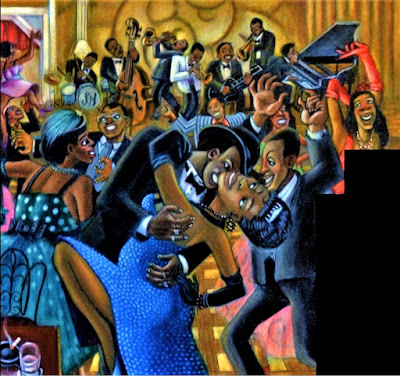“Oh, Mrs. Dalloway…always
giving parties to cover the silence.”
The Hours - the 1998 Pulitzer Prize-winning novel by Michael
Cunningham
When I finished
reading Virginia Woolf’s celebrated 1925 novel, Mrs. Dalloway (an inner monologue of a 1920's society woman as she prepares for one of her many self-distracting parties), the first
thing that occurred to me was how remarkable it is that someone had actually found a way
of committing to the printed page that restless state of lying in bed, wanting
to sleep, but being unable to because one’s brain will simply not turn off. I
never would have imagined the rules of grammar could accommodate such an
accurate depiction of the way the busy mind, stimulated by darkness and silence, sets about the delicate
balancing act of entertaining several simultaneous, often contradictory,
thoughts while erasing the distinctions between past and present. All in a
manner so emotionally vivid that it feels as though an entire lifetime has been
lived in one’s mind while lying in a state of turbulent calm during the wee small
hours of a sleepless night.
I was also struck
by the canny way Woolf’s not-so-easy-to-grasp stream of consciousness prose—communicating
the myriad thoughts, impressions, and reactions of her characters by way of free-form,
intermingled, inner monologues—so poetically captured a personal trait of my own
that has plagued me for as long as I can remember: the habit of overthinking
everything. A tiresome habit that grants equally weighty consideration to all experience,
trivial to significant, till even the smallest activity or interaction occasions
an "off to the races!" mental barrage of feelings, rear-view ruminations, and emotional responses.
 |
| Vanessa Redgrave as Mrs. Clarissa Dalloway |
 |
| Michael Kitchen as Peter Walsh |
 |
| Sarah Badel as Lady Sally Seton Rosseter |
 |
| John Standing as Richard Dalloway |
These days, technology—by
way of smartphones, earbuds, and the like—does its part in making easy-access distraction
the preferred method by which individuals can readily seal up the cracks of silence that would
otherwise allow for the painful intrusion of introspection and
self-confrontation. But back in Virginia Woolf’s post-war London of 1923,
particularly as it applies to one Mrs. Clarissa Dalloway of Westminster, one
had to make do with throwing parties.
 |
| Natascha McElhone as Clarissa Parry (young Mrs. Dalloway) |
 |
| Alex Cox as young Peter Walsh |
 |
| Lena Headey as young Sally Seton |
 |
| Robert Portal as young Richard Dalloway |
Advancing age
and illness have conspired to make Clarissa sensitive to her isolation and loneliness (her daughter's nearly grown, she and her husband sleep apart) fueling
her barely-acknowledged depression and fostering within her a sense of futility
of purpose. Though she largely succeeds in valiantly suppressing these emotions
through an obstinate refusal to let the Gods "have their own way" and a staunch observance of the social norms befitting her wealth and status
as the wife of a member of Parliament; Mrs. Dalloway nevertheless remains haunted by echoes
of her youth. A time when life held for her the potential of a more vital existence.
The reappearance of a past suitor (the unmoored Peter Walsh, whose proposal of marriage Clarissa rejected to wed the more dependable Richard Dalloway) trigger memories of the impossible but very real love she felt for her cigar-smoking, free-thinking friend Sally Seton. A mutual spiritual and sexual attraction whose repressed passion now challenges Mrs. Dalloway’s fragile sense of happiness.
The reappearance of a past suitor (the unmoored Peter Walsh, whose proposal of marriage Clarissa rejected to wed the more dependable Richard Dalloway) trigger memories of the impossible but very real love she felt for her cigar-smoking, free-thinking friend Sally Seton. A mutual spiritual and sexual attraction whose repressed passion now challenges Mrs. Dalloway’s fragile sense of happiness.
 |
| Rupert Graves as Septimus Warren Smith |
 |
| Amelia Bullmore as Lucrezia (Rezia) Warren Smith |
Running concurrent
to Clarissa Dalloway’s story is a parallel, mirroring narrative involving the tortured Septimus
Warren Smith and his desolate wife Rezia. Septimus is a shell-shocked WWI veteran whose mental deterioration and
difficulty in readjusting to postwar life reflect Clarissa’s depression and
isolation…only rendered in stark, bas-relief.
Septimus’ mental
illness (manifest in trauma-induced hallucinations and suicidal thoughts tied
to suppressed feelings for a fellow soldier whose death he witnessed) is of the
unruly, socially-unacceptable kind. While Clarissa, forearmed by years of aristocracy-born
training in learning how to stifle emotions, is able to channel her own mental
illness (depression and a melancholy fixation with death) into socially-acceptable,
gender-mandated pursuits like hostessing.
Yet in spite
of their differences and never meeting (the film devises a moment, not in the
book, where each catches a glimpse of the other in a moment of vulnerable
recognition), Clarissa and Septimus have much in common. Principally, an intense guardianship of the soul, a love of
poetry, an appreciation of nature, and a sense of life’s beauty even when overwhelmed
by the fear of never being able to feel anything.
Connected by
duality, their fates take tragically different paths. But each, in their way, succeeds in their determined resistance to surrendering their private selves to the control of others. A small
victory perhaps, but for each, a distinct act of courageousness. In a world of you
must and you should, the fight to preserve the
privacy of one’s soul is the ultimate triumph of self-ownership.
Virginia Woolf’s
interpersonal stream-of-consciousness narrative is transferred to the screen with
a conventional Masterpiece Theater/ Merchant-Ivory fidelity that I nonetheless
found to be deeply affecting and superbly realized in its casting and the depth
of its performances. Relying on voiceovers and flashbacks, Dutch filmmaker Marleen
Gorris (director of 1989s Best Foreign film Oscar winner Antonia’s Line) and screenwriter Dame Eileen Atkins (co-creator of the 1971 BBC series Upstairs, Downstairs) may not have been able to come up with a cinematic style equivalent to Woolf’s distinctively fluid, intimate prose, but the relatively straightforward
approach given the material achieves a kind of melancholy poetry.
WHAT I LOVE ABOUT THIS MOVIE
I came around to
reading Mrs. Dalloway by a somewhat circuitous route. A few months ago, my
partner, knowing I’d never read any Virginia Woolf at all, by way of an
introduction to the author gave me a copy of the 1975 short story collection Mrs.
Dalloway’s Party: A Short Story Sequence. The accessibility of this introduction into
the world of Clarissa Dalloway led me to seek out the movie adaptation, which
then made me feel I was at last ready to tackle the novel itself.
I absolutely
adored the book. So much so that I’m glad I saw the film first. Had the sequencing been reversed, I would have
come to the film with far too many impossible-to-meet expectations. As it is, the film was able to enchant me on its own merits, the novel helping to inform the screen characters with a greater depth not possible given the relative brevity of a film's running time.
I ended up watching the movie a second time, during which the book seemed to work in concert to give me a greater understanding of Woolf’s themes and a richer
experience overall.
 |
| "It's so very dangerous to live for only one day." |
 |
| "They were meant to be red." |
It's a great gift when a film can make me cry, and at times Mrs. Dalloway achieves moments of such heartbreaking beauty and sensitivity, that the waterworks dam overflows. Nothing but praise for the luminous color cinematography by Sue Gibson and the delicate, affecting musical score by Ilona Sekacz.
THE STUFF OF FANTASY
As a story about a woman hemmed in by the gender limitations of the time and her social status, Mrs.
Dalloway shares several of the themes found in one of my all-time favorite
plays (and Glenda Jackson movie): Henrik Ibsen’s Hedda Gabler. For
starters, the title of each work conveys the central conflict of self-identification facing its characters. The lack of a first name
in Virginia Woolf’s book reflects the heroine’s sense of the loss of her individuality in marriage (“Mrs. Dalloway, Mrs. Dalloway. I’m not even Clarissa anymore”). On the opposite spectrum, the maiden name emphasis of Ibsen’s title stresses how little his anti-heroine
identifies with her married name of Hedda Tesman.
 |
| The solitary Peter Walsh haunted by his love for Clarissa "She broke my heart. And you can't love like that twice." |
In terms of character, Clarissa and Hedda are not at all alike, yet both struggle with depression and feelings of isolated powerlessness within their marriages. Victims of their aristocratic upbringings, the women may chafe at the constraints of their social class, but both are, in their hearts, snobs who place great stock in their position and how they are perceived. The latter concern, in particular, leaving them paralyzed when it comes to taking action towards achieving the liberation they crave. The one area of true defiance they share is in refusing to allow themselves to fall under the power of another; a theme that...in both works...leads to an act of suicide as an act of self-possession.
 |
| "Then came the most exquisite moment of her whole life...." |
The filmed Mrs. Dalloway never replicates the "busy mind" sensation I got from reading the book, but in its place, via the elegant soulfulness of so many of the performances, I found a stronger emotional empathy with its characters. Simply gorgeous how the film reflects on the pain of repressing one's sexuality, the fluidity of love, and the fleeting elusiveness of happiness.
THE STUFF OF DREAMS
When I think
of Mrs. Dalloway, what lingers in my mind are Vanessa Redgrave’s sad,
haunted eyes; Natascha McElhone’s heartbreaking youthful exuberance; and the rawness of Michael
Kitchen’s wounded romantic spirit. Superb performances abound, but Vanessa
Redgrave's Clarissa touches my heart and Natascha McElhone is incandescent. Together, their
performances bring Clarissa Dalloway to vivid life and bring a tender cohesion
to the spirit of the novel’s theme of a life lived in one day.
“I remember thinking: ‘She’s
abandoned me.’ And then, all of a sudden, she was there with her hand stretched
out…looking utterly beautiful, saying: ‘Come on, come on. They’re all waiting.’”
Like Stephen
Sondheim’s Follies, Edward Albee’s A Delicate Balance, and Herman
Hesse’s Steppenwolf; Mrs. Dalloway is a work I don’t think I could
have appreciated, let alone understood, had I come across it in my youth. A person
needs a few years on them to recognize that it is far too easy in life to take
joy for granted, and one needs a lifetime’s worth of losses and regrets to appreciate
the truth that pursuing happiness is never
a superficial goal or waste of time. What trivializes it is when it's used as a numbing retreat from life's struggles, or as a means of blotting out the sound of life’s silences.
 |
| Mrs. Dalloway's Party |
BONUS MATERIAL
 |
| Dame Eileen Atkins in The Hours |
Mrs. Dalloway marks the screenwriting debut of actress Dame Eileen Atkins (Gosford Park) and what a remarkable first effort it proves to be. Atkins appeared as the flower shop merchant in the Mrs. Dalloway-linked film The Hours (2002), and in 1991 she starred Off-Broadway as Virginia Woolf in the one-woman show A Room of One's Own.
Scene from "Mrs. Dalloway" 1997
 |
| Fear no more the heat o' the sun. Nor the furious winter's rages. Cymbeline - William Shakespeare |
Copyright © Ken Anderson 2009 - 2019


















































